Arepas: A Staple From My Childhood Kitchen
The most versatile bread for breakfast, lunch, or dinner, that is super easy and quick to make
Hi :) my name is Maria and I was born and raised in Venezuela.
This post is all about arepas and I like to keep my recipes clear and to the point—no endless scrolling to get to the ingredients. BUT this post is kind of a big deal for me.
If you’d like to read a little about my upbringing in Venezuela and why arepas mean so much to me, you’ll find that story at the bottom of this post.
I grew up eating arepas nearly every day for breakfast, lunch, or dinner. Sometimes I would even have them for a couple or even all meals of a given day.
Arepas are round, corn-based breads made from just three ingredients: corn flour, water, and salt. Their origins go back to Venezuela’s Indigenous people, long before colonization. The word “arepa” itself comes from erepa, the word for corn used by the Cumanagoto people, an Indigenous tribe native to Venezuela. For me, they’re at the heart of my heritage—a food that represents both comfort and versatility.
One of the things I love most about arepas is how naturally adaptable they are. They’re made with corn flour, which means they’re completely gluten-free. You can keep them simple and serve them warm with butter, make them vegetarian or vegan with plant-based fillings, or stuff them with meats and cheeses for something heartier.
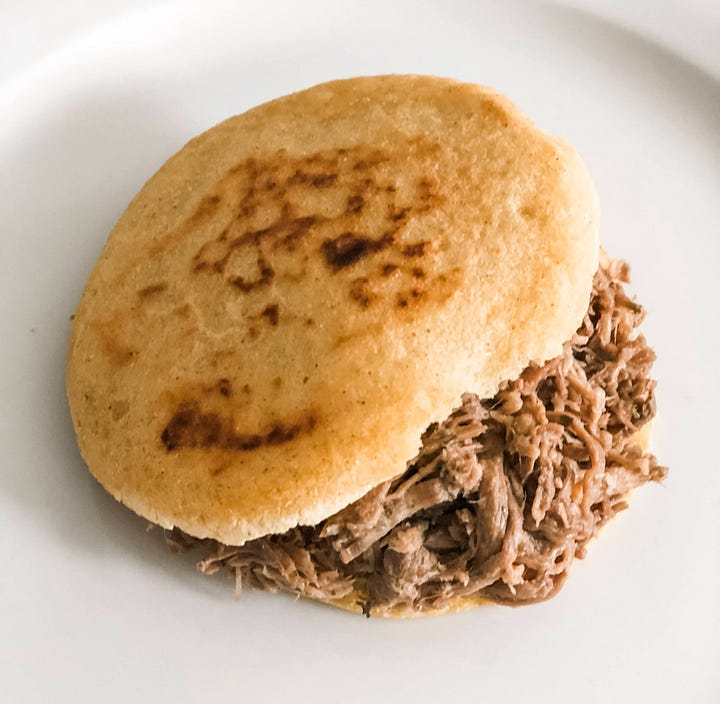
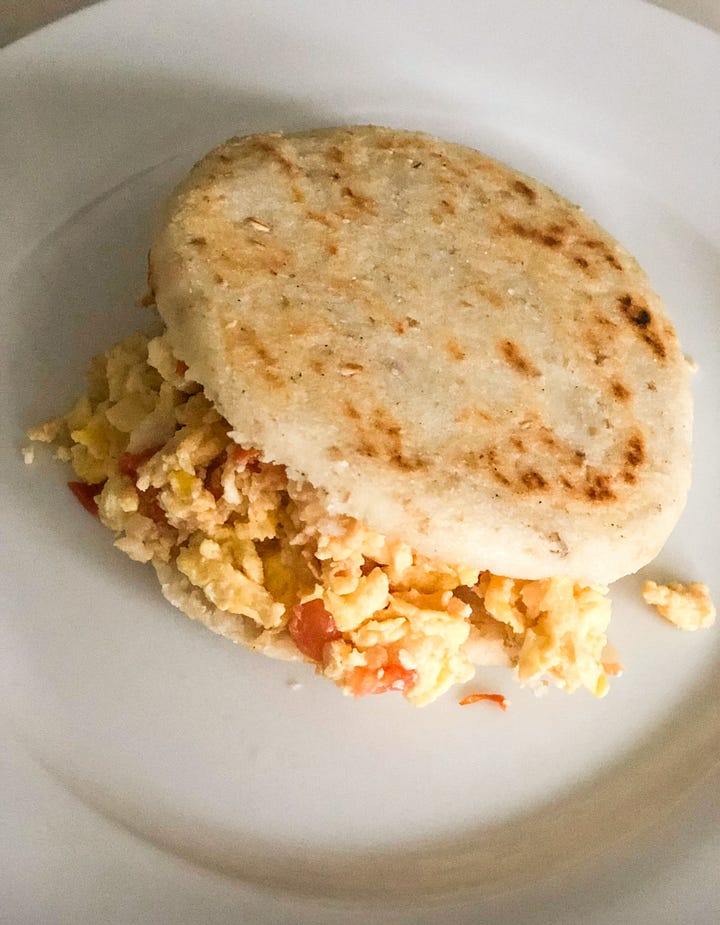
They’re also family-friendly in every sense. Kids can help make the dough, and you can even make them into fun shapes to encourage little ones to join in. The dough is forgiving and easy to handle, which makes it perfect for getting everyone involved.
On top of all this, arepas can be as colorful and nourishing as you’d like. By mixing in pumpkin purée, beets, spinach, or even black beans, you can change their color and boost nutrition. They truly are a food that adapts to the needs of the moment, while always holding onto their roots.
Equipment Needed
A bowl and a fork or spatula
A griddle or cast iron pan
Ingredients For The Dough
120 g (1 cup) precooked white or yellow corn flour (such as P.A.N.)
240 g (1 cup) lukewarm water + extra in case you need it
3 g (1/2 tsp) salt
Optional Fillings
Scrambled or fried eggs for a breakfast favorite
Butter and cheese for a quick, traditional snack
Ham and cheese for a classic lunch
Shredded beef or chicken for a hearty meal
Avocado, beans, veggies, or tofu for a vegetarian/vegan twist
Instructions
Mix the dough. In a medium bowl, combine the warm water and salt. Slowly add the precooked corn flour, mixing with your hands until a smooth, pliable dough forms. Let it rest for 10 minutes so the flour can fully absorb all the water and you can evaluate the final texture. The dough should feel moist but not sticky. If it cracks when you shape it, add a teaspoon of water at a time until it feels soft.
Shape the arepas. Divide the dough into equal portions (about the size of a golf ball for smaller arepas or a tennis ball for larger ones). Using wet hands and a clapping motion, flatten gently into discs about ½ inch thick. Smooth out the edges using the palm of your hand.
Cook. Heat a lightly oiled skillet or griddle over low heat. Place the arepas on the hot surface and cook for 5–7 minutes per side, until a golden crust forms. They should sound hollow when tapped in the center.
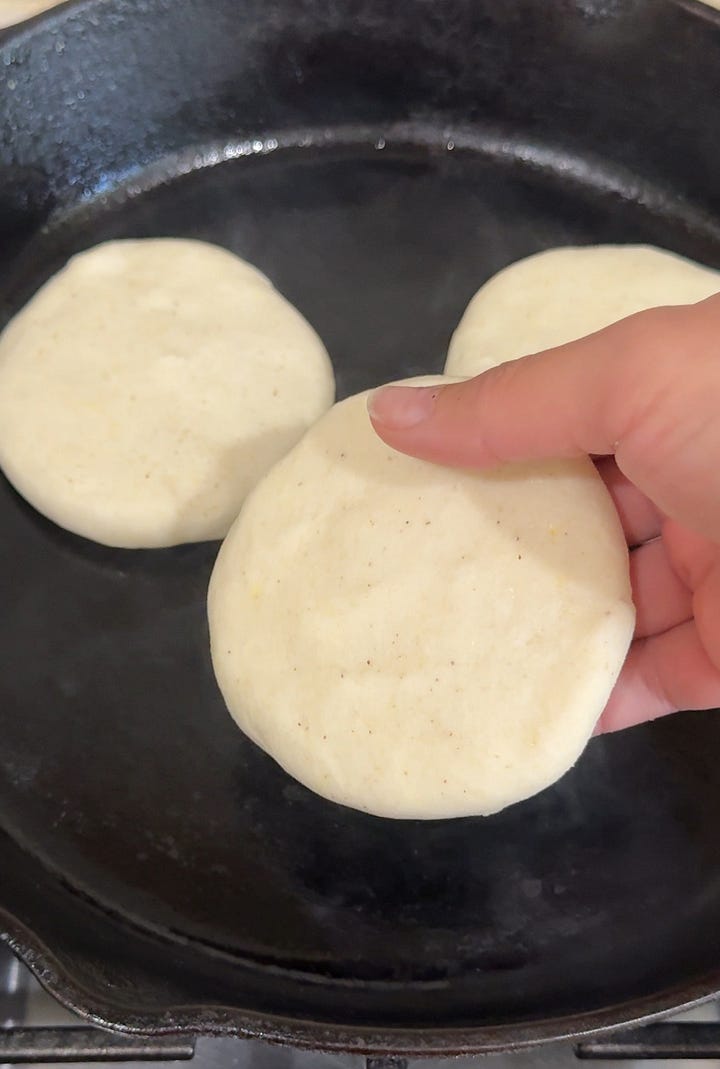
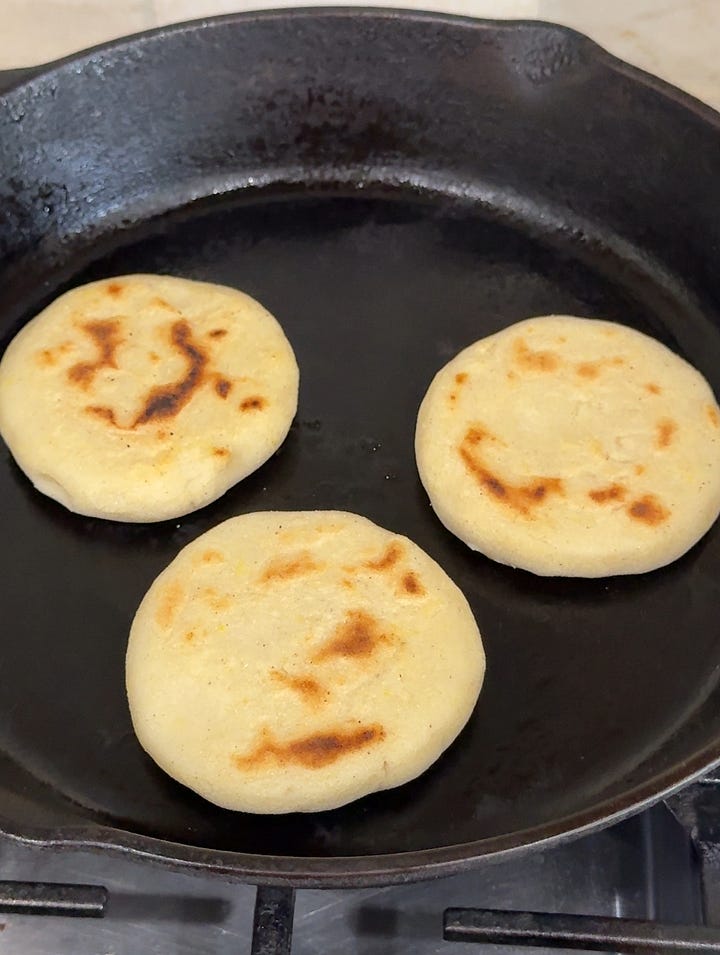
Split and fill. Once cooked, let the arepas rest for 2–3 minutes. Slice them open halfway and fill with your favorite fillings. Serve warm.
Tips
If you want a crispier outside, finish the arepas in a preheated oven at 375°F (190°C) for 5–8 minutes after pan-cooking.
Add grated cheese, mashed vegetables, or purees directly into the dough for extra flavor and nutrition.
To save time, shape arepas ahead and store them covered in the fridge for 1-4 days. Cook them fresh when ready to serve.
Cooked arepas freeze well. Reheat in the toaster or oven straight from frozen, but nothing beats a warm, freshly-made arepa.
Thank you for allowing me to share this tradition with you. I hope arepas find a place in your kitchen and become a food your family reaches for again and again.
If you’d like to read more about my upbringing in Venezuela and the memories behind this recipe, keep reading:
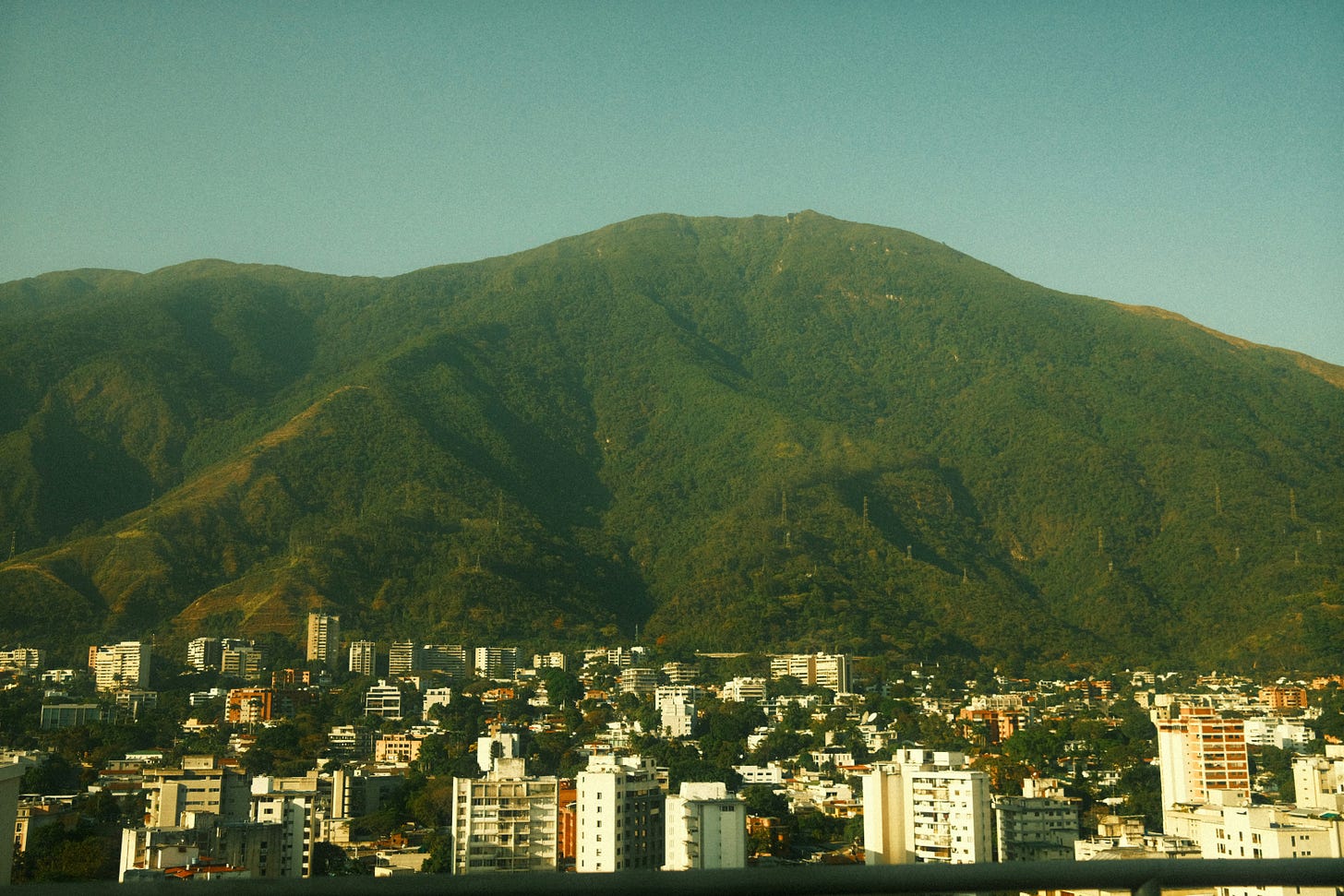
Venezuela: Beauty, Wealth, and Resilience
I really don’t know how to talk about my home country without tearing up a little, but here it goes.
If you don’t know much about Venezuela let me summarize it for you:
#1 It’s BEAUTIFUL
#2 Venezuela was once one of the wealthiest countries in the world. Its economic prosperity was driven almost entirely by our vast oil reserves, which are the largest proven reserves in the world.
#3 Unfortunately, it was taken over by a ruthless government, keeping all the wealth in their pockets while keeping the people poor and desperate. That’s why Venezuela is not a safe country to visit nowadays.
Venezuela is a very unique and special country and here is why:
Venezuela is home to Mount Roraima, one of the world’s oldest geological formations, estimated to be nearly 2 billion years old. While Earth itself is about 4.6 billion years old, most of its earliest rocks have been erased by erosion, volcanic activity, and shifting tectonic plates. Mount Roraima is remarkable because it has endured all of that—it is one of the oldest things still standing on our planet.
Venezuela is also home to Angel Falls, the tallest uninterrupted waterfall in the world. Dropping nearly 1,000 meters (3,212 feet) from the edge of Auyán-tepui, a massive tabletop mountain, the water often turns to mist before reaching the ground.
The Catatumbo lightning is a rare natural phenomenon that takes place in Venezuela, where storms light up the sky for as many as 260 nights each year. For hours at a time, lightning flashes continuously—often without thunder—creating a dramatic and reliable light show. Known as the world’s most consistent lightning storm, it is another striking example of Venezuela’s extraordinary natural wonders.
The Orinoco River is one of the longest and most important rivers in South America, winding for more than 1,300 miles through Venezuela.
In a relatively small geography, you can visit breathtaking Caribbean beaches, towering mountains capped with snow, rolling desert dunes like those in Coro, and vast tropical forests alive with wildlife. This diversity makes the country one of the most unique and beautiful places in the world.
Now put all of these facts together and what do you get? Natural wealth just beneath the surface. Venezuela was once one of the richest countries in the world, thanks in large part to its vast oil reserves—the largest proven reserves anywhere on the planet. Beyond oil, the country is also rich in natural gas, gold, and other precious metals. This abundance has long made Venezuela a land of extraordinary potential, where the richness of the earth mirrors the richness of its culture and traditions.
Venezuela’s Indigenous population was relatively small and was decimated during colonization, which led to early mixing with Europeans. Over time, this gave rise to a population with a unique blend of features and traditions. Later, while much of the world was enduring wars and hardship, Venezuela was growing in prosperity, with vast natural wealth still largely untapped. That promise of opportunity attracted immigrants from Spain, Italy, Portugal, Germany, Lebanon, and many other places.
This mix of backgrounds also shaped the people themselves. Venezuelans are known around the world for their beauty, and it’s no coincidence that Venezuela holds more international beauty crowns than any other nation. That same diversity is reflected not only in our traditions, but also in the people who carry them. The arrival of so many groups brought new foods, music, and customs, all of which blended into the vibrant and diverse culture that defines Venezuela today.
It breaks my heart that the current government has made it unsafe for me to return to visit my family, or to let my husband and children be immersed in the beauty of our country. Venezuela deserves so much more than what it has endured.
While I can’t be there physically, I carry it with me always. Every time I make our traditional foods, I feel a little closer to home. Cooking is my way of remembering, honoring, and keeping alive the memories of a country that gave me so much.
My Upbringing in Venezuela
I grew up in Venezuela in a home shaped by strong women. My parents divorced when I was three, so I was raised by my mom, who worked as a teacher. She carried the weight of providing for me and my two siblings on a teacher salary, but she was not alone—my two aunts, also teachers, stepped in to support us. Neither of them had children of their own, so they poured their love and energy into helping my mom raise us. Thanks to them, I never felt I lacked anything.
My mom made sure I had what mattered most: I was well cared for, well dressed, and able to attend a private Catholic school (since public education in Venezuela wasn’t the best). But with most of her salary going toward school fees, groceries had to stretch. That’s why arepas became such a constant presence at our table.
Arepas weren’t just affordable; they were comforting and versatile. They filled us up, and with just a few different fillings, they never felt repetitive. Over time, they became tied to some of my happiest memories. Like waking up to the clapping sound of my mom making arepas, happy breakfast would be served soon; or like my sister calling me “arepa face” because, before puberty, my face used to be pretty round and I didn’t have much of a neck. She would also call me “pozo sin fondo” or “bottomless pit” because I could eat so much. Ah! siblings can be so sweet, right?

Another favorite memory linked to arepas is from my college years, when areperas—restaurants dedicated entirely to arepas—were open 24/7. After a weekend night out dancing salsa, merengue, and reggaetón with friends, we’d head to one of these spots, hungry and tired, and eat one or sometimes even two arepas before heading home. The meals were tied to moments of pure joy, when I was still buzzing from the music and dancing I could feel in my body, surrounded by friends as we laughed, chatted about the cute guys we had danced with, or swapped stories from our week at college. Those late-night arepas, warm and satisfying, will always be some of my happiest food memories.
Even as an adult, arepas have continued to shape my story. After my second baby, I followed a vegetarian diet for about 18 months. During that time, I discovered just how fun and colorful arepas could be. By mixing vegetables and different ingredients into the dough, I created versions that were not only beautiful but also packed with nutrition. It showed me again how versatile arepas are—they adapt to your life stage, your tastes, and your needs, while always carrying the same sense of comfort.
I hope you enjoyed learning about arepas, Venezuela, and even a little about my own life and special memories. I would love for you to try making them in your own kitchen, and if you do, please tag me (@leafandloafco on Instagram or @leafandloaf on TikTok) so I can see your creations and share in your arepa story too.
Questions or recipe requests?
If you love my content, please consider sharing it with friends and family. Every share helps spread this movement — and as a thank you, you’ll earn free months of subscription.
Paid subscribers, here is the neat printable for your very own recipe binder.
Check out this post on how I keep my tried-and-true recipes organized, so they are easy to find. A great keepsake to pass down generations :)
Keep reading with a 7-day free trial
Subscribe to Bringing Bread Back to keep reading this post and get 7 days of free access to the full post archives.









